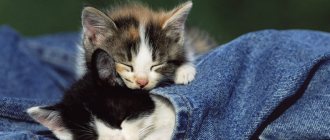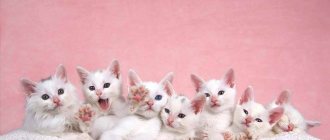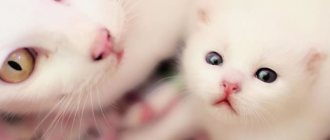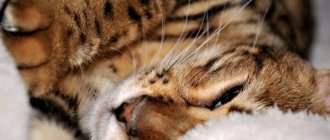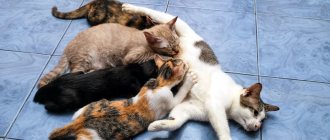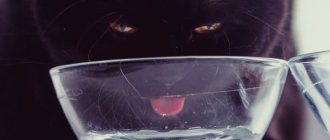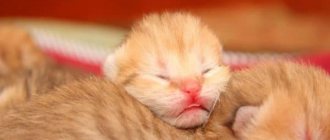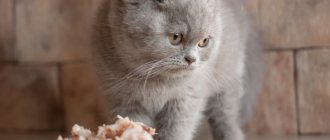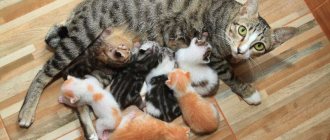Features of digestion depending on age
Cats belong to the order of carnivores, the class of mammals.
Immediately after birth, the baby needs mother's milk. With it, he receives micronutrients, proteins, vitamins, fats and, most importantly, immunoglobulins, which form the immune system of the future predator. The mother feeds the offspring until they are three months old. The enzyme lactase is produced in the small intestine of kittens. It is responsible for the digestion of milk sugar (lactose).
Mother's milk
From a month on, the cubs gradually begin to taste meat. The amount of breast milk consumed decreases, but it still takes up a significant part of the diet. As the kitten grows up, serious changes occur in its body. Lactase production decreases. The digestive system produces more and more proteases necessary for the breakdown of proteins.
Three months is the age when a kitten becomes an adult and stops receiving milk from its mother. By this point, the body has already adjusted to a meat diet, and lactase practically ceases to be produced. There is not enough enzyme to process lactose, so milk causes unpleasant symptoms (pain, diarrhea) in most adults.
What's wrong with the cat? Possible reasons for abandonment of offspring
How to understand what is wrong with a cat and why she refused kittens? It is important to understand that cats very rarely abandon kittens, since they have highly developed instincts for caring for their offspring. You can understand the reasons by observing the young mother.
If a cat hisses, rushes at the kittens, tries to hit them with her paw or strangle them, most likely the babies were born prematurely and the young mother considers them unviable. In this case, it is useless to insist on the kittens being taken back; it is better to try to feed the babies yourself.
If a cat has given birth for the first time, she may refuse kittens due to severe stress. In this case, there is a chance to “persuade” the young mother to accept the offspring back. Keep a close eye on the cat, she will look for a more reliable shelter for her offspring. Once the cat finds shelter and settles down in it, do everything to move the nest closer to her. If necessary, move furniture, empty cabinets, but give the young mother the opportunity to choose what she considers a safe shelter for her offspring.
A cat may abandon kittens if her health or life is in danger. The most common cause of abandonment of offspring immediately after birth is eclampsia. This condition is life-threatening for the young mother, so it is necessary to contact a veterinarian. Postpartum eclampsia is eliminated by injections of drugs containing calcium.
If a cat has problems with the functioning of the hormonal system, alarming symptoms may appear immediately after birth. Most often, we are talking about the inability to process glucose, as a result of which the young mother falls into a state of shock. Shock can be relieved with insulin, however, be sure to contact your veterinarian for a more accurate diagnosis.
Details
Basic Rules
We present the basic rules, following which you can figure out how to raise and feed a 1-month-old kitten without a cat at home:
1. Food for a one-month-old kitten should have a liquid consistency. Solid inclusions and pieces should be avoided. The kitten will hardly be able to digest such food. 2. When feeding a small kitten for up to a month, use various feeding devices. Bottles with rubber nipples can serve as such devices. 3. Each new product is introduced into the diet gradually and in small portions. 4. Do not overfeed your baby. Control the amount of food in the bowl. 5. Introduce new foods into the kitten’s diet not immediately, but gradually. Give each new product every 3-4 days.
IMPORTANT: Provide the kitten with clean drinking water in the required quantity.
How to train a one-month-old kitten to eat on its own
The kitten begins to show interest in adult food at the age of 3 weeks.
He watches with interest how other animals eat. Complementary feeding should begin with dairy products. Pour milk into a saucer, dip your finger in it and let the kitten lick it. The baby will understand that it’s delicious and will reach for the cup himself.
Then you can poke the kitten's muzzle into the milk, but be careful not to choke. In any case, give the kitten freedom of movement and freedom of choice. He himself will reach for a cup of milk and start lapping it up. Don't think that you will succeed the first time. Be patient and repeat the procedure again. It is normal for the kitten to snort and sneeze.
A baby kitten can get its paws right into the bowl. To wean your kitten from such a bad habit, wipe its wet paws every time.
Hold him by the neck so he doesn't go all the way into the bowl. Be patient with your little pet and after a few days the kitten will learn to eat on its own. The owner of a kitten is always conflicted about whether it is better to feed the kitten dry food or natural food.
Cat breeders debate the benefits all the time. Ready-made cat food is a balanced product. The manufacturer adds everything you need to it: vitamins, healthy additives and microelements. From the point of view of veterinarians, dry food is worthy food for an animal.
Cautions
But with any approach, you need to recall important features:
- If you start feeding your kitten natural products, do not add dry food to its food. The fact is that the process of digesting dry food and natural food is different. Therefore, if you do not want your animals to encounter problems such as gastroenteritis and gastrointestinal colic, then do not feed natural food and dry food at the same time.
- You should not feed your kitten with industrial food of different brands at the same time, this will either lead to an excess of some vitamins or to vitamin deficiency. Digestive problems are also possible.
- Don’t skimp on your pet’s health, buy proper and high-quality food. The kitten should be fed with a product of the “Premium” and “Superpremium” classes.
If you decide to feed your kitten natural food, then adhere to the following rules:
- Diet variety. If from an early age an animal gets used to one type of food, then in the course of its life it will hardly be possible to accustom it to another. Offer your kitten a variety of foods.
- You should not feed your kitten food from your table. Human food contains salt and spices that are harmful to cats.
So what should you feed a one-month-old kitten, besides milk?
You can give complementary foods in the form of cottage cheese. Stir cottage cheese with milk until it reaches a consistency similar to sour cream. The next product that you will introduce into the diet of a month-old kitten is chicken yolk, but it should also be mixed with milk. Porridge with meat and milk broths, soups with broth without spices, and boiled vegetables are good for a kitten.
You can use different products, the main thing is that they are not greasy and are well chopped. Kittens should not be given meat from fatty animals, such as pork, goose, and duck. Add organ meats to your food. Meat should not be given to a kitten raw; it must be boiled first. Fish should not be given to cats often. Frequent consumption of fish leads to kidney disease. For castrated animals, fish is excluded from the diet altogether.
The food of a small kitten should be close to natural. Food should be warm and natural. Do not feed foods that are too hot or very cold. Make sure that the kitten always has clean water.
Feeding regimen or how many times should a kitten be fed 1 month old:
1. Kittens up to two weeks old are fed at least 7 times a day. All feedings are divided into equal time intervals. 2. Kittens aged from 2 weeks to 1 month are allowed to eat 6 times a day. 3. A kitten older than 1 month should receive food 6 times a day in small portions.
A single serving of food for a one-month-old kitten is 30 ml per 100 g of weight. A kitten over 1 month of age is given 50 ml per 100 g of food weight at a time.
When and how to switch to solid food?
They begin to offer solid food only after babies confidently begin to drink from a saucer. You can offer special balanced food for kittens or make a paste with the consistency of oatmeal from crushed dry food and milk (infant formula). You should bring a finger lubricated with gruel to the kitten’s lips and give him the opportunity to sniff the food. Then you should smear the lips, lightly pushing the food into the mouth. Wait until the kitten tastes, chews and licks. Then you can bring it to the saucer with food and wait until the baby sniffs it out on its own and starts eating without outside help.
After the kittens begin to fully eat only “adult” food, go to the toilet in a tray and can do without the cat’s mother for a long time (age 10-12 weeks), then the offspring can be distributed into the wrong hands.
Can kittens have milk from a cow?
If, for a number of reasons, a kitten can no longer feed on mother’s milk, the owner is faced with the task of choosing the most suitable analogue. The first thing that comes to mind is cow's milk. This product is widely represented on the market, it is affordable and can be found in any store. But can you give it to a kitten? Unfortunately, there are many reasons why this choice should be abandoned.
Cow's milk is intended for newborn calves. Its composition is rich in vitamins and beneficial microelements, many of which are suitable for cat babies. But some substances are not needed by the kitten’s body and are even dangerous:
- the protein contained in cow's milk can cause diarrhea or allergies;
- estrogen is a female hormone present in the milk of a pregnant cow, which negatively affects the kitten’s hormonal levels;
- antibiotics that cows receive on farms can cause dysbiosis;
- Some of the pesticides contained in cow feed end up in the milk and can cause severe poisoning in a kitten;
- pasteurized dairy products from the store are practically devoid of nutrients and beneficial substances.
Feeding with cow's milk
How to teach to eat liquid food from a saucer?
It is better to provide a special milk formula for kittens as food during weaning hours.
Giving cow's milk is not recommended due to frequent cases of indigestion, diarrhea or constipation. It is strictly not recommended to put a kitten's face in a saucer with formula/milk; the baby may inadvertently inhale droplets of liquid and develop pneumonia.
The owner should dip a finger into the liquid and touch the kitten's lips with it. The kitten must lick itself. Repeat the procedure until he begins to lick milk directly from his finger. Then dip your finger in the saucer and hold it there until the kitten comes to the saucer and starts lapping up the milk right from there next to the finger.
Features of goat milk
Goat's milk is better for kittens than cow's milk. Its composition is more acceptable to their body.
Goat milk has a number of undoubted advantages over cow milk:
- in terms of fat content it is closer to cat fat;
- fats and proteins are easily digestible;
- low-allergenic;
- contains less lactose;
- contains a lot of lacto- and bifidobacteria, which have a positive effect on the intestinal microflora and the digestive process;
- a significantly higher percentage of vitamins and mineral compounds.
If there are no contraindications, kittens can be given goat's milk. To reduce the fat content, it must first be diluted with water.
It is very important to buy the product from trusted farmers, making sure in advance that the goats are healthy, well-nourished and kept in decent conditions.
Kitten feeding schedule. Up to the third week inclusive
For the first five days, a newborn kitten needs to be fed every 2-3 hours, day and night. The daily norm is 30 ml of the mixture per 100 grams of weight. Further, until they reach the age of two weeks, the kittens are fed every 4 hours throughout the day. The amount of food increases to 40 ml per 100 grams of weight. During this time, kittens need some kind of cat's milk substitute. The milk of any mammal is intended exclusively for the cubs of its species, so you should never give kittens any kind of milk in its pure form. You can use cat milk substitutes, which are sold in pet stores, or prepare your own formula. To prepare it you will need 4 parts of boiled cow's (or goat's) milk and one part of egg white. The ingredients must be mixed until a homogeneous mass is obtained. If kittens cannot tolerate cow's milk (you will notice this immediately because problems with stool will begin), you can try giving them infant formula (very weakly diluted). It is convenient to feed kittens using a pipette or a medical syringe without a needle. You need to give them the mixture very carefully, because if it gets into the lungs, the kitten will choke. If this suddenly happens, immediately turn him upside down to clear the airways. In addition, care must be taken to ensure that no air gets into the kitten’s stomach while eating. To do this, hold the pipette or syringe at an angle of approximately 45 degrees. After feeding, kittens need to gently massage their tummies with a dampened piece of cloth to stimulate digestion and help them release their natural needs. Under normal conditions, this is done by the mother cat. The kitten should “go to the toilet” 2-3 times a day. You can store the finished milk mixture in the refrigerator for no longer than a day; syringes and pipettes used for feeding must be boiled regularly.
Unless your kittens are abandoned or separated from their mother, their weight will still need to be monitored. Slow weight gain indicates that they are undernourished. If kittens begin to suck the finger extended to them and squeak all the time, they are hungry. If you notice this, increase the amount of food for the mother cat. Sometimes some kittens get enough milk, while others remain hungry. In this case, hungry kittens should be placed closer to the belly of a nursing cat. If the cat does not have enough milk for all the kittens, you need to start feeding them additionally.
Milk during feeding
A kitten, left without a mother from the first days, needs adequate nutrition for normal development. The owner's first step is to try to get cat milk for the little pet. To do this, you need to find a nursing cat and give her another baby. If this method fails, it's time to think about an alternative.
Many pet food manufacturers produce special complementary foods that will become the baby’s main diet until he is one month old. These are mixtures that include milk powder, cream, yeast, eggs, as well as all the elements necessary for growth.
The preparation process is simple - pour liquid into the powder and mix thoroughly. Usually a daily supply is prepared immediately, which is kept in the refrigerator to preserve its benefits and freshness. Before feeding, the required amount of the mixture is heated to 38 ⁰C.
Veterinarians recommend adding a little more liquid to the powder than indicated on the package. This will help avoid constipation.
Various feeding mixtures
When making a choice in favor of one or another product that replaces mother's milk for kittens, you need to consider several points:
- the manufacturer and brand must be well-known and have positive reviews from specialists and breeders;
- The breed of the pet largely determines the required calorie content of the mixture;
- fat content – for children the limit value is 9%.
Meat puree can be gradually introduced into the menu of a bottle-fed kitten from the age of one month.
Is it possible to rewind a cat to burn off the milk?
Pregnancy, childbirth and lactation of cats are special and exciting events, and therefore are often surrounded by various superstitions that have come down to us from the times when it was not possible to buy special food for a cat, take it to a veterinarian, or find a medicine.
For example, people often ask how to properly rewind a cat so that the milk burns out. This issue is probably related to the custom of women to bandage their breasts when weaning a baby from breastfeeding. Maybe this method helped someone relieve pain, but there is no scientific evidence that people or cats necessarily need to tighten the mammary glands to stop lactation.
In addition, a cat who has just been separated from her kittens needs care and attention, and attempts to wrap her belly will most likely only frighten the cat and increase stress.
As we have already said, the cessation of lactation is facilitated by proper weaning of kittens and diet - as a rule, if these rules are followed, everything should go well for your pet. If for some reason mastitis begins, then the best solution would be to immediately contact a veterinarian.
Although there are various folk remedies for mastitis, we would not recommend that you treat your cat on your own.
General recommendations
- When babies are one month old, teach them to have short but regular separations from their mother. Let the four-legged little one spend a couple of hours a day in his own “house” with dishes, a bed and a toilet.
- If the kitten does not yet know how to eat from a bowl, it is placed on its tummy and fed from a syringe. First remove the needle and gradually squeeze out the liquid contents drop by drop into the mouth so that food does not get into the windpipe. A more convenient feeding device is a bottle purchased at a pet store with a set of nipples.
- Do not deprive a mother cat of all her babies at once. Otherwise, the nurse’s mammary glands will become overcrowded and will hurt. Together with the stress experienced, this will lead to health problems.
- Introduce kittens to the smells of the new home and its inhabitants, including fauna. Periodically sniffing the personal belongings of the owners (T-shirt, T-shirt) and the pet (sheets, toys) will help you get used to the “aura” of your future habitat.
- When parting with the mustache, give the new owner the bedding on which the baby slept in the “father’s house.” Native smells will help the tailed “new resident” feel more confident in an unusual environment.
Read:
How many toes does a cat have on its paws: normal and abnormal
How long does it take for a cat's milk to burn out?
The time it takes for a cat to lose or burn out milk under normal conditions depends on many factors, including how you distribute the kittens.
It is best to separate kittens from the cat one at a time, 3-4 months after birth, taking a break of 3-4 days. It is advisable to prepare the cat and kittens 2-3 days before this event. Several times a day, kittens are taken away from the cat for 1-2 hours in another room, leaving them with food, water and cat litter. This way they gradually get used to independence.
If the kittens were given away unexpectedly
But what if for some reason the kittens had to be given away at the same time or too early?
In this case, on the first day you need to not give her food and water, and then begin to gradually increase their amount. If the cat is too worried, looking for and calling kittens, give her a special sedative for cats, pay more attention, pet her, create a calm environment in the house. At the same time, to stop lactation, you need to reduce the amount of water and food consumed by the cat.
You can follow this scheme: on the first day, do not give the cat food at all and give only half of the amount of water it usually consumes, on the second day - give a quarter of the usual portion and half a portion of water, on the third day you can give as much water as it wants, and a little more food than the previous day.
Can adult cats?
Nutritionists call for completely eliminating milk from the animal’s diet for six months. It is at this age that the production of lactase in the cat’s body reaches a minimum, which means that milk sugar will practically not be broken down. This may result in diarrhea and vomiting.
Some cats drink milk into old age without negative consequences. That is, their body continues to produce the necessary enzyme in sufficient doses. But this is rather an exception to the general rule and is associated with the individual characteristics of a particular pet.
Almost all animals like the taste of milk, but the product does not benefit an adult cat. On the contrary, in most cases, consuming the product can lead to poor health:
- the high calorie content of whole milk can disrupt metabolism and cause obesity;
- the high content of lactose and casein interferes with normal absorption, disrupting the functioning of the gastrointestinal tract;
- development of an allergic reaction;
- Lactose intolerance leads to deterioration of digestive functions, bloating, flatulence, diarrhea, and dehydration.
- It was delicious!..
How long can a small kitten live without food?
A young and healthy cat with a normal build can do without
food for about two weeks.
For older individuals (over 7–8 years old), forced fasting for one week can be fatal. Very small kittens
will not be able to withstand this:
without
food, they usually die within a day.
Interesting materials:
How much semolina do you need for 750 ml of milk? How much rice do you need for a 5 liter pot of soup? How much sugar do you need per liter of raspberries? How many skins do you need for a beaver fur coat? How many skins do you need for a fox fur coat? How much should you salt crayfish? How much fresh yeast is needed for 1 kg of flour? How long does it take to study to become a Prosthetist? How much vinegar do you need instead of citric acid? How many nationalities live in Kazakhstan?
Lactose intolerance
Milk is the first food for cats, like other mammals. The baby's body secretes enough enzyme to process milk sugars. Gradually, the animal switches to solid food, and lactase production decreases.
Once milk is removed from the diet, the body permanently stops producing the enzyme. This means the animal loses the ability to normally digest dairy products. This explains why adult cats should not drink milk. Their body can no longer process this product.
In animals that are fed milk from childhood, lactase continues to be produced. They can consume the product in small quantities to avoid consequences.
Comfort
It is very important that mother and children have their own place. The mother often begins to look for a place for a nest while she is still pregnant. Therefore, to prevent the cat from finding it in an unexpected and unwanted place, prepare everything yourself by allocating a comfortable zone for the expectant mother. You can simply place the box, insulating it with a blanket. It is important that this nest is located in a quiet and safe place.
The litter in the nest must be changed. You can use a blanket or towels. After the cat gives birth, you need to change the bedding, first every day, then as needed. It is necessary that the bed is always dry and clean.
It is very convenient to use multi-layer bedding. When one layer becomes dirty and wet, you can simply remove it. In this case, cleaning the nest will be much easier.
The cat should be free to move her kittens wherever she wants. You can guide her, but don't insist. The main thing is that the place she chooses herself is safe.
Kittens need to be gradually accustomed to being handled. Watch the cat's reaction; if she is against your actions, you need to wait for her approval. But contact with kittens will allow them to get used to people and make parting with the cat easier.
Feeding procedure
- Sit in a comfortable position, lay a bedding on your knees - a towel, a diaper;
- The kitten needs to be placed in the same position as when sucking milk from a cat - standing, lying on its stomach with an elevated position;
- Squeeze out a little product so that the kitten feels the smell, takes the pacifier in its mouth, if this does not happen, carefully insert it into the mouth, then instinct will react;
- You need to feed a newborn with a pipette; you should not squeeze out the contents. It is necessary for him to develop a sucking instinct; he does it himself;
- After about 7 days, you need to switch to a syringe, but squeeze out the milk slowly so as not to choke.
Features of mother feeding kittens
Almost immediately after lambing, the cat produces colostrum. This is a milk-like substance containing a large number of useful components. Colostrum is especially rich in antibodies, which provide immunity to newborns in the first days of life. Gradually, the level of antibodies decreases, and colostrum becomes mother's milk. For newly born babies, it is the main food for several weeks. Only with the secretion of the mammary gland can kittens receive proteins, fats, carbohydrates and substances necessary for the normal development of the body.
What to feed kittens: reviews
Of course, nursing kittens is a rather complex manipulation, so we recommend that you read the reviews of kitten owners.
What to feed kittens, reviews
Veronica, 30 years old . I became the owner of two kittens completely unexpectedly for myself. Not far from our multi-storey building, a cat brought kittens, but for some reason, at the age of about 2 weeks, she threw them out of her den. The two kids could barely move around the yard, as they practically couldn’t walk. Their paws moved in different directions. Judging by the not fully open eyes, I concluded that the babies were about 2 weeks old. I fed the babies approximately every 3 hours. I purchased a special mixture. In addition, the kittens constantly meowed and called for their mother. I placed the box with the babies near the radiator. I think it was cozy there. For another two weeks I woke up at night and fed the kittens. Already at the age of one month she began to give regular cow's milk and special canned food.
Elena, 35 years old. I live in my own house, and not long ago we got a new cat in our yard. As I understand it, she came to us already pregnant. After she brought the kittens, she disappeared somewhere. As a result, I had to take care of 4 kittens. To do this, I prepared the mixture myself from cow’s milk, eggs and sunflower oil. She fed with a syringe. Unfortunately, one of the four kittens died. No matter how hard I tried to massage him, he defecated with great difficulty. 5 weeks have passed, three kittens are running around the yard, they are healthy and playful.
Evgeniy, 30 years old. My cat recently gave birth to kittens, but unfortunately, due to health problems, we had to take her to the veterinary clinic. We were advised to temporarily wean the cat away from kittens due to eclampsia. We gave vitamins and injections because the cat stopped walking with her hind legs. The kittens had to be looked after on their own. I have three children who regularly monitored the babies’ condition. They were fed with a special mixture, which was purchased at a veterinary clinic. A week later, the cat came to her senses, but, unfortunately, due to lack of milk, she was unable to feed them. But she continued to lick them, so all questions regarding bowel movements, as well as cleaning the babies, disappeared. The cat performed these duties independently. But we had to feed. Now the kittens are alive and healthy, gaining weight well. The cat also recovered.
Friendship
Remember, an animal is not only a source of food for its babies, but also a heater and a nanny. You will have to perform all the functions of a mother.
Why does a cat abandon kittens?
In most cases, the cat's behavior is influenced by stress. This is possible due to frequent births. If an animal gives birth twice in a season, the body is under a lot of stress. Accordingly, older kittens are just weaned, and new kittens appear in their place.
The cat is physically exhausted and may produce very little milk. Animals understand that there are no means to feed new offspring, so they abandon them.
Why does a cat abandon kittens?
- Eclampsia. This is a lack of calcium in a cat's body, which can cause it to die. A large amount of calcium is released along with milk, as a result of which bones begin to break down. The balance of electrolytes in the animal’s body is disrupted.
- Hormonal imbalance.
- Estrus immediately after birth. This also happens, although it is considered a pathology.
- Cat's unpreparedness for kittens , first birth.
- Too noisy place, excessive attention to kittens from people.
Kittens
Vitamins and supplements needed for babies
Artificially fed kittens need to be given vitamins and mineral supplements. From 4 weeks you can give your babies Canina Cat-Mineral Tabs. It is a source of calcium and phosphorus, promotes the proper formation of bone and cartilage tissue.
From 6 weeks, kittens can be given the Kitty's Junior supplement from the Beafar company. This drug improves the quality of babies' fur and has a beneficial effect on the skin, as it contains biotin.
Also, from 1 month, kittens can be given Gelabon Glucosamine tablets from the Polydex company. This drug, like Canina, promotes the proper formation of cartilage and bone tissue in babies.

